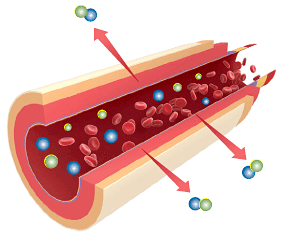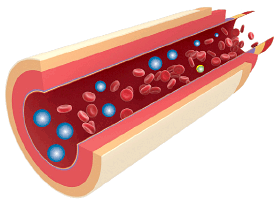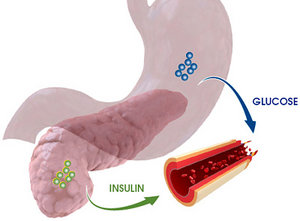To Your Health
November, 2008 (Vol. 02, Issue 11) |
|
|
Breaking Down Diabetes
When a food is being digested, enzymes in your stomach break down carbohydrates into glucose, which is then absorbed into your bloodstream. Your pancreas responds by releasing insulin, which allows glucose to travel to the liver, where it is distributed to cells for energy. Excess glucose is stored as glycogen and reconverted to glucose if blood sugar levels fall and more energy is required. In general, this is the normal, healthy picture of the blood glucose response.
With type 1 diabetes, the pancreas doesn't secrete insulin at all. As a result, glucose has no way of getting into the body's cells, and blood sugar levels stay high. With type 2 diabetes, the pancreas secretes insulin, but not enough to meet your body's needs. In both cases, glucose builds up in your bloodstream.
 Normal Blood Glucose Response
Normal Blood Glucose Response
The pancreas produces adequate insulin to transport glucose from the bloodstream.
|
 Abnormal Response (Diabetes)
Abnormal Response (Diabetes)
The pancreas produces inadequate or no insulin, leaving glucose in the bloodstream.
|
Normal blood glucose levels range between 60 mg/dL and 120 mg/dL; however, these levels generally are much higher in diabetics. Because glucose stays in the bloodstream, rather than being made available to cells, diabetics can suffer a variety of health problems, including poor circulation and blood flow. Among the worst potential complications are nerve damage, blindness, cardiovascular disease and stroke.
 How Food Becomes Functional
How Food Becomes Functional
Carbs break down into glucose and are absorbed into the bloodstream. The pancreas releases insulin, which helps transport glucose to the liver, where it is distributed to cells for energy.
Ronald Klatz, MD, is the president of the American Academy of Anti-Aging (www.worldhealth.net), a nonprofit organization dedicated to the prevention, detection and treatment of aging-related disease.
Robert Goldman, MD, is the chairman of the American Academy of Anti-Aging (www.worldhealth.net), a nonprofit organization dedicated to the prevention, detection and treatment of aging-related disease.

